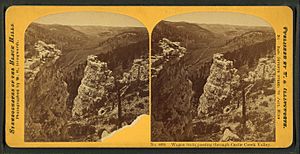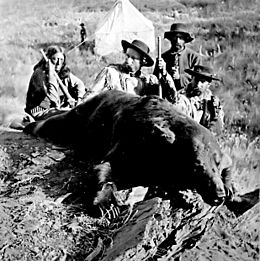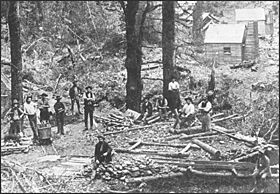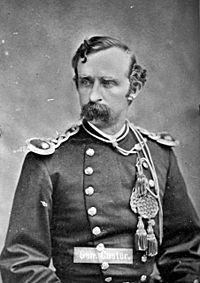Black Hills Expedition facts for kids
Quick facts for kids Black Hills Expedition (1874) |
|||||
|---|---|---|---|---|---|
| Part of the Sioux Wars | |||||
|
|||||
| Belligerents | |||||
| Commanders and leaders | |||||
| Units involved | |||||
| 7th United States Cavalry Regiment | |||||
| Strength | |||||
| ~1,200 Soldiers and Civilians | |||||
| Casualties and losses | |||||
| 1 killed | |||||
The Black Hills Expedition was a journey by the United States Army in 1874. It was led by Lieutenant Colonel George Armstrong Custer. The expedition started on July 2, 1874, from what is now Bismarck, North Dakota. Back then, it was Fort Abraham Lincoln in the Dakota Territory.
Their mission was to explore the Black Hills of South Dakota. This area was largely unknown to white settlers at the time. The army wanted to find good places for a new fort. They also looked for a route to the southwest. A big part of their mission was to see if there was gold.
Custer and his group, the 7th Cavalry, reached the Black Hills on July 22, 1874. They were ordered to return by August 30. They set up a camp where the town of Custer would later be built. While the soldiers looked for a fort location, civilians searched for gold. It's still debated how much gold they actually found.
However, news of possible gold led to a huge gold rush. This made the Sioux Native Americans very angry. The U.S. government had promised to protect their sacred land through treaties. This conflict eventually led to the Great Sioux War of 1876–1877. Custer was later killed by the Sioux at the Battle of the Little Bighorn.
An English photographer named William H. Illingworth joined the expedition. He was chosen by Captain William Ludlow, the expedition's engineer. Ludlow paid Illingworth $30 a month to take photos for the U.S. Army. Illingworth took 70 photos in total.
Contents
Exploring the Black Hills
Starting the Journey to the Black Hills
Custer began his expedition with about 1,000 to 1,200 men. They had 110 wagons, many horses, and cattle from the 7th Cavalry. They also brought artillery and enough food for two months.
The expedition included Native American scouts. These scouts were led by Bloody Knife and Lean Bear. At that time, the Black Hills were mostly unexplored by white people. Few expeditions had ever returned from there.
Captain Hardy, Custer's engineering chief, said he knew about the Black Hills. He had them marked on his maps. However, he had never actually entered them. On their way, Custer's group found Hardy's old trail. They saw two lines of sunflowers that had grown along the ruts of his wagons.
Deep Inside the Black Hills
Custer and his group entered the Black Hills from the north. They moved slowly, sometimes only four or five miles a day. On July 31, 1874, the wagons reached Harney Peak (now Black Elk Peak). Custer and Ludlow, with a few men, climbed to the top.
Meanwhile, the rest of the group set up camp at the base of the mountain. They called this spot Custer Park. While most of the force stayed there, Custer took a smaller group. He wanted to find a good place for a new fort. By August 2, 1874, this group reached a spot they named Agnes Park. It was about eight and a half miles southeast of the mountain. They had several peaceful meetings with Native American groups. On August 7, Custer shot and killed a grizzly bear. He later said this was his greatest hunting achievement.
The Discovery of Gold
During the expedition, civilian experts looked for minerals. They found traces of gold in the rivers. The first person to find gold is not officially known. However, a miner named William McKay kept a diary. He wrote that while camping at Custer Park, he went prospecting. He found gold in his first pan of gravel and sand from the creek bed. He estimated it was worth "from one and a half to two cents." This was the first gold found in the Black Hills.
A big discovery happened on August 1. Tests of the soil near French Creek showed that a miner could earn up to $150 per day. Custer wrote a letter on August 15, 1874, to the Assistant Adjutant General of Dakota. He stated, "there is no doubt as to the existence of various metals throughout the hills." He added that "examinations at numerous points confirm and strengthen the fact of the existence of gold in the Black Hills."
Scout Charley Reynolds carried Custer's messages to Fort Laramie. From there, the news was sent by telegraph to newspapers in the east.
"There is no doubt as to the existence of various metals throughout the hills. As this subject has received the special attention of experts who accompanied the expedition, and will be reported upon in detail, I will only mention the fact that iron and plumbago have been found and beds of gypsum of apparently inexhaustible extent. I referred in a former dispatch to the discovery of gold. Subsequent examinations at numerous points confirm and strengthen the fact of the existence of gold in the Black Hills."
The group stayed at Agnes Park until August 15. Then, they turned around to go back to Fort Lincoln. The expedition returned on August 30. The Native American scouts went back to their reservations on September 10. In total, Custer and his forces traveled 883 miles over 60 days.
Who Was Part of the Expedition?
The 7th Cavalry had many different roles during the Black Hills Expedition of 1874. Here are some of the key people:
- Leaders:
- George Armstrong Custer, Lieutenant Colonel
- Frederick D. Grant, Lieutenant Colonel and acting aide
- George A. Forsyth, Major
- Cavalry Company Commanders:
- Captain Myles Moylan (Company A)
- First Lieutenant Benjamin H. Hodgson (Company B)
- Captain Verling Hart (Company C)
- First Lieutenant Thomas M. McDougall (Company E)
- Captain George W. Yates (Company F)
- First Lieutenant Donald McIntosh (Company G)
- Captain Frederick W. Benteen (Company H)
- Captain Owen Hale (Company K)
- First Lieutenant Thomas W. Custer (Company L)
- Captain Thomas French (Company M)
- Medical Team:
- Dr. John W. Williams, chief medical officer
- Dr. S. J. Allen, Jr., assistant surgeon
- Dr. A. C. Bergen, assistant surgeon
- Engineering Team:
- Captain William Ludlow, chief engineer
- W. H. Wood, civilian assistant
- Mining Experts:
- Horatio Nelson Ross
- William McKay
- Scientists:
- George Bird Grinnell
- Newton Horace Winchell
- A. B. Donaldson
- Luther North
- Photographer:
- William H. Illingworth
- Newspaper Reporters:
- William E. Curtis, from the Chicago Inter-Ocean
- Samuel J. Barrows, from the New York Tribune
- Nathan H. Knappen, from the Bismarck Tribune






